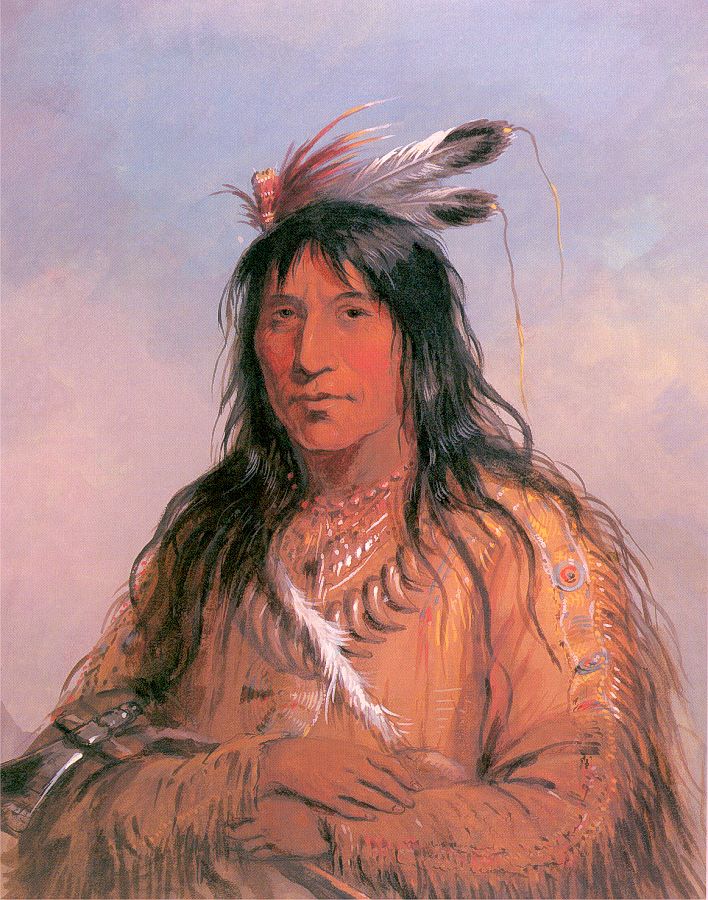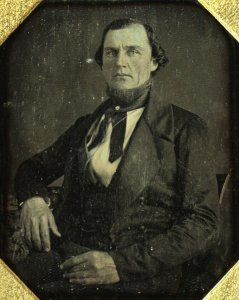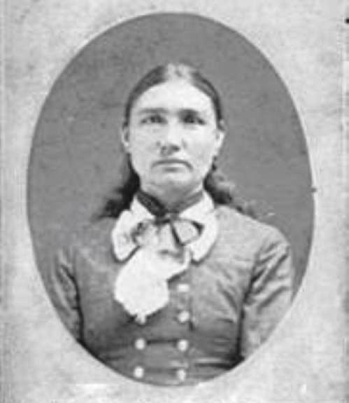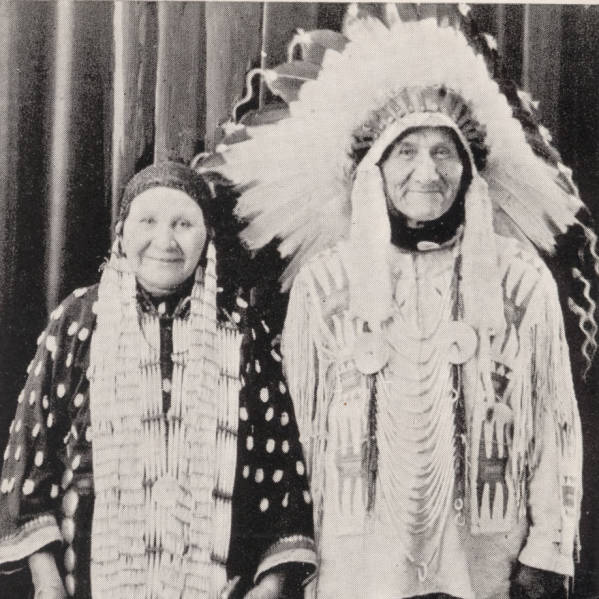|
|
Post by Dietmar on Jun 24, 2011 10:01:31 GMT -5
We already had some new and very interesting information about Bull Bear in the Smoke-thread, so I think it would be useful to have an own thread on Bull Bear:  Bull Bear painted by Alfred Jacob Miller in 1837 W. Smoke posted this info: Marcell Bull bear (an direct descendant of Bullbear & cousin to Adolph Bull bear); he only told me this...
on Bull bear;
born; 1790 & death; 1841
his father; chief Stone knife
Bull bear was only child of Stone knife!
Bull bear had 4 wives from some other Lakota sub-bands, O sage, Ponca, or Southern-Southern Cheyenne Tribes!
Bull bear had 6 children... only sons & no daughters;
Bull bear II, Little wound, Thunder bull, Spotted eagle, Little chief & Bull bear III!
Bull bear was the chief of the Kiyaksa band of the Oglalas from 1834 to 1841!
Read more: amertribes.proboards.com/index.cgi?board=oglala1&action=display&thread=239&page=7#ixzz1QCmyZH2O Today the Bull Bear family is mostly Oglala Lakota Sioux but also from the Cheyenne, O’ Sage & Ponca Tribes from Kansas Territory!
Because after the feud & split with Smoke in 1834, Bull Bear took his division way down south to the Kansas Territory to hunt & lived for awhile. So Bull Bear & some of his people married into Southern-southern Cheyennes, O’ Sages & Poncas!
When they traveled back to the Dakota Territory, they ran into a war party of Smoke’s warriors. A couple months later, Bull Bear & his division ran into Smoke’s Camp again in 1841!
Bull Bear got killed, so his oldest son: Bull Bear II note: this isn’t Young Bull Bear III of Smoke’s division. He took over as the Chief of his father’s division, the Cut off or Bear people. Until his death in the 1865 then his brother Little Wound was made chief!
Note: there were 2 Young Bull Bears, but the older one kept the name just “Bull Bear”!
It go like this;
Chief Bull Bear - chief Bull Bear II - Oscer Bull Bear - "chief" Royal Bull Bear - "chief" Adolph Bull Bear
Chief Bull Bear - chief Bull Bear II - Jesse Bull Bear - Maurice Bull Bear - Marcell Bull Bear
After Little Wound & his son George LW; Turning Hawk was made chief. Then Royal got it back into the Bull Bear family!
Read more: amertribes.proboards.com/index.cgi?board=oglala1&action=display&thread=239&page=9#ixzz1QCmPD7K9 Note that we already have a thread with many photos of Little Wound, Bull Bear´s son: Little Wound:amertribes.proboards.com/index.cgi?board=oglala1&action=display&thread=378 |
|
|
|
Post by Dietmar on Jun 24, 2011 10:09:55 GMT -5
This is Henri Chatillon, son-in-law of Bull Bear, who maried Bull Bear´s daughter Bear Robe.  ...and their daughter Emilie Chatillon Lessert:  |
|
Henri
Full Member
  
Posts: 103
|
Post by Henri on Jun 24, 2011 10:54:20 GMT -5
Dietmar,
I re-read the former messages of Wendyll, and he doesn't mentioned that Bull Bear had a daughter.....only sons.
So to whom is Bear Robe a child of???
Henri
|
|
|
|
Post by Dietmar on Jun 24, 2011 11:33:08 GMT -5
Good question. It is said in many sources that Bear Robe Woman was a daughter of Bull Bear, I think this is mainly from Francis Parkman who recorded it in the 1840s. Also look here: amertribes.proboards.com/index.cgi?board=news&action=display&thread=720If Wendyll says Bull Bear had no daughter, could she be a niece instead, which would make her also a "daughter" in Lakota kinship terms? |
|
|
|
Post by miller7513 on Jul 11, 2011 20:29:56 GMT -5
I believe the dates are slightly ajar-this Bear Robe is the daughter of Bull Bear b 1769 married to a Brule woman and married Henry Chatillon Sr b abt 1797
The husband of She Who Wears a Bear Robe could have been only Henry Chatillion Jr, the guide of Francis Parkman
miller7513
|
|
|
|
Post by Dietmar on Aug 10, 2011 6:23:41 GMT -5
This is a photograph from the McCracken Collection at the Buffalo Bill Historical Center. Are they descendants/relatives of the famous Bull Bear?  Bull Bear & wife, Sioux tribe, ca. 1920s |
|
|
|
Post by Dietmar on Apr 18, 2012 10:36:57 GMT -5
A German website visitor asked me to post these questions about the Kuhinyan division of the Oglalas. I think it fits best in the Bull Bear Family thread:
I am particularly interested in the history of the Oglala's and its "tiyospayes".
Can someone help me?
Which tiwahes belong to the Kuhinyan-division and to the Hunkpatila-division of the Oglala in the period 1820-1840?
Had "Bull Bear" the Kuhinyan from his father's family ("Stone Knife tiwahe" = Kiyuksa) split off? How can we explain that "Little Wound" led the Kuhinyan tiwahe later, although his grandfather had lead the Kiyuksa tiwahe?
Which were the families (tiwahe) of "One Eye" and "Whirlwind" ("brothers" of Bull Bear)?
|
|
|
|
Post by kingsleybray on Apr 18, 2012 14:28:44 GMT -5
"Which tiwahes belong to the . . . . Hunkpatila-division of the Oglala in the period 1820-1840?"
My reconstruction of Oglala bands in the first quarter of the 1800s would read like this:
The Oglala tribe c. 1800 numbered roughly 1000 people, growing to 1500 by 1825 and to 2250 by 1839 (all figures approximate!). The growth exceeds the norm for the Tetons as a whole, so I hypothesise that significant in-migration from other Tetons wasa fundamental fact in Oglala demographic history.
There were in 1800 two large - what I call 'maximal' - bands, or oshpaye, the Oglala proper or "Okandandas" (Tabeau) and the Shiyo (Tabeau's "Chihaut"), each of several hundred people. Tabeau indicates that the Okandandas were the larger band.
Concentrating on the Oglala proper, I reconstruct them in c. 1800 as comprising three distinct camps (wichoti) or sub-bands, each of about 200 people. In turn each camp included a nest of extended family groupings or tiyoshpaye. A typical tiyoshpaye numbered 50-100 people.
The three Oglala proper camps, with their constituent tiyoshpaye, looked something like this:
A. TRUE OGLALA
1. Sitting Bear (grandfather of American Horse;shifts to Kuhinyan c. 1830+)
2. Bad Face (a remnant of a once powerful band; Fast Whirlwind belongs to this family line, as does Brave Bear the father of the Sword brothers; shifts to Kuhinyan c. 1810+)
Through population growth a third tiyoshpaye is emerging, but will join the Oyuhpe maximal band c. 1830+, led by Ghost Boy; while a single tiyoshpaye probably drawing from both other sub-bands will remain with the Oglala proper. Among its headmen by 1840+ is Yellow Thunder, father of Little Big Man, and likely a kinsman of Sitting Bear and his son Three Bears.
B. TASHNAHECHA
1. Bad Wound (shifts to Kuhinyan 1845)
2. growing across 1800-25 is a second tiyoshpaye identified with two 'sons' of Bad Wound I, No Water I (born c. 1800), and Black Rock (born c. 1805). Of these, Black Rock will remain with the Oglala proper, but No Water will shift to Kuhinyan, 1825+. (Later, 1851+, No Water's sons will lead their group, by then identified as the Badger Eater camp, to rejoin the Oglala proper.)
3. Stone Knife-White Swan. This tiyoshpaye, in which the sons of White Swan were growing up (Bull Bear, Mad Dog, Iron Hatchet, Self-Met), would form the core of the Kuhinyan band, growing by incorporation of in-coming migrants and astute marriage strategies to become an independent maximal band in its own right. A 'brother' of Bull Bear's, Smoke, born into the Tashnahecha would draw to his following many Bad Face people as internal band tensions deepened, leading to a feud btw the Smoke and Bull Bear factions.
C. HUNKPATILA
1. Standing Bull
2. Yellow Eagle
3. Black Elk-Makes the Song (Crazy Horse).
This camp remains stable throughout the early 19th c., and all sub-bands remain with the Oglala proper. Indeed the whole Oglala proper maximal band is identified by the name Hunkpatila by 1839 (Nicollet).
One Eye or Le Borgne belonged to the Minishala (Red Water) band. This band was rated as Brule, but a part joined the Oglalas c. 1840.
The Kuhinyan band had a long history that links it I believe to the Kiyuksa division, a powerful Eastern Dakota (Santee) village in the early 18th c. Most of the village went west and joined the Tetons and Yanktonai. There was a stigma against the Kiyuksa name, hence I believe the coining of the new name Kuhinyan. At an early stage in the Bull Bear-Smoke feud a woman kinsman of Smoke taunted a girl of the opposite faction as "Kiyaksa", a typical Lakota punning on old names. So that name got stuck to the girl's tiyoshpaye (it may be the family of Bull Bear's brother Mad Dog), and by 1860+ it was generally applied to the whole maximal band, and the Kuhinyan name began to go out of usage.
There's a lot more detail, but I hope this helps clarify a lot of data. It is frankly speculative, but I think it matches the evidence. It would be great to bash ideas about and refine the detail.
|
|
|
|
Post by kingsleybray on Apr 18, 2012 16:12:14 GMT -5
In 1839 Nicollet estimated the Kuhinyan band as comprising 100 lodges, approximately 750 people.
By that time at least two significant sub-bands had joined the core Kuhinyan tiyoshpaye that I identified above. In 1804, I believe following the hunka reformation described by James R. Walker's Oglala informants, a wichoti joined the Kuhinyan that I propose was cored on the family of Little Bull, the putative paternal grandfather of Whistler (aka Little Bull), prominent in the period 1865-72. Some of these families may have come from the Miniconjou.
In 1820 I believe a second camp came from the Brules to augment the Kuhinyan. My feeling is that, like the Stone Knife-White Swan tiyoshpaye, they had been part of the Oglala tribe from about 1776, but joined or rejoined the Brule circle at the end of the 1790s. There was a strong Kiyuksa band within the Brule hoop (associated closely with the Wacheunpa/Meat Roasters band) and the various Kuhinyan tiyoshpaye 'floated' btw the Brule and Oglala summer ceremonial loci. The 1820 incomers comprised two tiyoshpaye, those of Two Arrows-Lone Man-Red Cloud, and of Man Afraid of His Horse II.
Meanwhile, the sons of Stone Knife-White Swan were marrying extensively and tightening around them a new cluster of tiyoshpaye. As an example Iron Hatchet formed a new group called Payabya, perhaps through deep intermarriage with the Man Afraid of His Horse family. As I indicated above, many Oglala proper were being drawn into this network, as were people from the Shiyo maximal band, that dissolved early in the 1830s, a part joining the Brule hoop. I suspect that the Shiyo remnant that stayed with the Oglalas, attaching to both Oglala proper and Kuhinyan maximal bands, may be ancestral to the later Spleen band.
|
|
|
|
Post by Dietmar on Apr 19, 2012 10:23:46 GMT -5
Thank you Kingsley,
so in the case of Le Borgne the mention “brother” to Bull Bear should not be taken as in the European sense.
I re-read Parkman´s “Oregon Trail” again. He mentioned these men as chiefs or prominent warriors in the “Ogillallah” villages in 1846:
Le Borgne or One Eye “brother” to Old Bull Bear
Young Bull Bear, eldest son of Old Bull Bear, not more than 20 years old, “had oftener struck the enemy, and stolen more horses and more squaws than any young man in the village”, admired by the young men and women in the camp
Old Red Water “great friend to the whites” about 80 years old
Eagle Feather, son of Red Water, “man of powerful frame, but of bad and sinister face”
Big Crow, “brother” of Eagle Feather, “one of the most noted warriors in the village” “had slain, as he boasted to me, fourteen men”
Mad Wolf, principal man among the Arrow Breakers society “a warrior of remarkable size and strength, great courage, and the fierceness of a demon”
Panther
White Shield, “warrior of noted prowess”
“a half-breed Shienne”
Arrow Head
Hail Storm (young, but bound to be a chief) (younger brother to The Horse)
Bad Wound
Whirlwind “prominent Ogillallah chief”
Old Smoke
also:
Old Bull Tail
The Stabber
|
|
|
|
Post by kingsleybray on Apr 19, 2012 14:44:00 GMT -5
Dietmar,
I don't know whether to accept Parkman's statement literally, that Le Borgne was the brother of Bull Bear. Le Borgne was over 80 in 1846, according to Parkman, so born c. 1765. Bull Bear's exact birthdate is not known, but he was two or three decades younger than Le Borgne. (The statement attributed to Little Wound by Walker, that his father Bull Bear was not yet born at the time of the hunka reformation, 1804-05, I think must be a misunderstanding on the part of Walker or his interpreter. Wislizenus in 1839 met Bull Bear and considered him "rather aged". Marcel Bull Bear's date of 1790 should be close.) I wouldn't rule out the possibility that Bull Bear and Le Borgne shared a parent, but we just don't know. This could be a case of the children of a man's brothers are classed as his 'sons'. I sometimes wonder if we have two or three brothers, ie. Bull Hoop, Stone Knife, White Swan, born across the frame c. 1740-1760, all of whom were classed as the 'fathers' of Bull Bear.
In Parkman's original journal by the way Red Water is indicated to be about 60 years old (not 80). He and Le Borgne were listed as the chiefs of the Minishala (Red Water) band by Nicollet in 1839, when it was still rated as Brule. In November 1841 David Adams names "the born" as one of four headmen in the Kuhinyan or Southern Oglala village on Chugwater Creek. So 1840 looks right as the year of the move to the Oglala hoop.
|
|
|
|
Post by kingsleybray on Apr 25, 2012 5:32:04 GMT -5
Here is the relevant information on the Bull Bear family line in the Scudder Mekeel Field Notes 1931, White Clay Dist., Pine Ridge Reservation, American Museum of Natural History.
p. 57 - Informant Spotted Elk (Spotted Eagle?): "Bull Bear had six sons, the first was Little Wound . . . The second was Bull Bear; the third, Cut Foot; the fourth, Left Hand; fifth or sixth Crazy Bull and Spotted Eagle, (my present interpreter). The second son, Bull Bear, has a son still living (Lawrence)."
p. 58 - informant Lawrence Bull Bear: "Lawrence gave me his genealogy. On the male side his great grandfather's name was White Swan whose son Bull Bear, was murdered in the 1840's by Red Cloud's group. Lawrence said that this Bull Bear had a title like Red Cloud or Spotted Tail's, but he don't know whether he was chief over all the Oglala. This Bull Bear would be Lawrence's grandfather. His father's name was also Bull Bear, the one who tried to assume his father's place. White Swan had only four sons: Iron Hatchet, Crazy Dog, Bull Bear, and Self-Met (Iye itcila). Thompson Brown Bull was the eldest son of Self-Met. These four sons of White Swan all had wives and many children. It was a big family after this - a big group which stuck together. Self-Met had a son named Spotted Eagle. Iron Hatchet was the founder of the Paiyabaya Band. He formed a band after they got so big, and this was the beginning of the Paiyabaya. The name of the Kiyaksa originally was Kunhinyan. A Red Cloud woman used this word against the Kiyaksa (? My informant had this twisted). Bad Wound was called a son-in-law, so married a Bull Bear woman. I discovered that Henry Chatillon, Francis Parkman's guide, was called Yellow White Man by the Indians. Parkman tells of his being married to a daughter of Bull Bear. Lawrence told me that this woman's name was Bear Robe. She had a daughter who later married Young Man Afraid of His Horses. Frank Young Man Afraid of His Horses, a son of this later union, I later met at Kyle. He is a half brother to Amos at Oglala."
Little Wound told James R. Walker that his paternal grandfather was called Stone Knife, who was the father of Bull Bear. He didn't mention the name White Swan.
|
|
|
|
Post by kingsleybray on Apr 25, 2012 6:03:38 GMT -5
"Which tiwahes belong to the Kuhinyan-division . . . . . in the period 1820-1840?"
I gave my thoughts above about what were the constituent tiwahes within the Oglala proper or Hunkpatila in the period 1820-40. Turning to the Kuhinyan (later also known as Kiyaksa) they were a later 18th c. offshoot from the Kiyuksa village I mentioned above, originally a Santee group that went west (c. 1725-50) and, breaking up, attached itself (c. 1750-75) by individual bands and camps to various Yanktonai and Teton groups. At the founding stage of the Kuhinyan (c. 1775+) a large admixture of Cheyennes married in, c. 1782 (Makula statement to Mekeel). In the years immediately following (c. 1785-1800) I think that they became extensively intermarried with the True Oglala band of Oglalas, creating a hybrid camp the Tashnahecha. At this stage they constituted one group within the maximal Oglala proper band. The Kuhinyan however through population growth became increasingly independent during the first third of the 19th c., creating by growth and controlling new hunting grounds a new maximal band of their own.
I should think by the 1820s that the core family lines within the Kuhinyan now looked like this:
1. Stone Knife-White Swan. Through the marriages of its sons, Bull Bear and the rest, this group was rapidly growing in this period. See Lawrence Bull Bear statement in post above. By this process this family line is drawing in large numbers of people from other Oglala bands (e.g. Oglala proper, Shiyo), and also from other Teton tribal divisions - Brule and Miniconjou are mentioned by Mekeel's informants - and the Cheyenne.
2. Little Bull. Chief of this name noted by Joshua Pilcher in 1835, he is possibly the grandfather of Whistler.
3. Two Arrows-Lone Man-Red Cloud.
4. Man Afraid of His Horse II.
Family groups 3 and 4 seemingly constitute one camp (wichoti), suggesting they had made extensive intermarriages in the generation c. 1785-1810. After 1810 I think this camp, which was in the period 1798-1810 running with the Brule, begins making marriage ties with the Stone Knife-White Swan group (no. 1 above), which results in a shift back to the Oglala hoop complete by 1820. An example: perhaps Mad Dog, Bull Bear's brother, marries a sister of Red Cloud-Lone Man, and their son is the Red Cloud killed by the Pawnees c. 1837. Another example: Iron Hatchet, the eldest (?) brother of Bull Bear, begins making marriage links to the Man Afraid of His Horse tiwahe, beginnning the process described by Lawrence Bull Bear above: the formation of a separate sub-band called Payabya. Note also that brothers Red Cloud then Lone Man married Walks As She Thinks, a sister of Smoke, the latter a 'brother' (i.e. cousin) of Bull Bear in the Tashnahecha camp, creating important new connections that will ultimately result in the re-chartering of a revived Bad Face band.
Various Oglala proper families had become attached to the Kuhinyan in the period 1805-34. These included, as I opined above, the Sitting Bear and Bad Face tiwahes from True Oglala; and the No Water tiwahe from Tashnahecha. In addition the Shkokpa band, recalled as of Brule origin by Charles Turning Hawk (statement to Mekeel), aligned itself to the Kuhinyan.
As Wendyll Smoke has shown us, 1834 marks the beginning of a crisis phase in relations within the band. Smoke, born into the Tashnahecha but now associated (by marriage?) with the Bad Face family group, and appointed a tribal Shirt Wearer (1824?), led the group opposed to Bull Bear. Smoke's following across the period 1834-45 realigns itself back to the Oglala proper maximal band. Connected somehow to this process was the movement of Man Afraid of His Horse III ('Old' Man Afraid, 1808-1889) to the Hunkpatila camp of the Oglala proper. He seems to have moved there around the time of the birth of his son (Young Man Afraid), c. 1835-36. Important to recall that he had existing family ties there already through the Yellow Eagle tiwahe, kinsmen of his father.
|
|
|
|
Post by hreinn on Apr 27, 2012 13:57:01 GMT -5
White Swan had only four sons: Iron Hatchet, Crazy Dog, Bull Bear, and Self-Met (Iye itcila). Was this Crazy Dog the same person as Mad Dog who Joseph N. Nicollet said was the head of Ku-Inyan Oglala in 1839 ? Hreinn |
|
|
|
Post by kingsleybray on Apr 27, 2012 14:51:34 GMT -5
That's correct, hreinn. The Lakota name is Shunka Gnaskinyan, Mad or Enraged Dog.
John Colhoff wrote my friend Joseph Balmer that Mad Dog was killed by Red Cloud at the same time as his brother Bull Bear. Colhoff linked Mad Dog to the Kiyaksa band. I'm unsure whether he meant that very specifically, i.e. to the original or True Kiyaksa family group; or whether he was using Kiyaksa in a more general way, equivalent to all Southern Oglalas, a tribal sub-division comprising several such extended family groups, e.g. Tashnahecha, Shkokpa, Kiyaksa proper and so on. Note how for Nicollet in 1839 the general overall name was Kuhinyan (he writes it Ku-inyan), whereas a generation later the general name for the same group was Kiyaksa.
|
|







